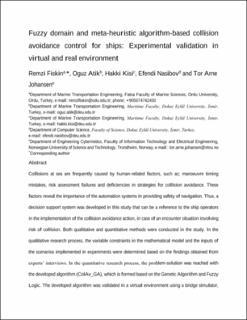| dc.contributor.author | Fiskin, R | |
| dc.contributor.author | Atik, O | |
| dc.contributor.author | Kisi, H | |
| dc.contributor.author | Nasibov, E | |
| dc.contributor.author | Johansen, Tor Arne | |
| dc.date.accessioned | 2021-02-09T13:44:34Z | |
| dc.date.available | 2021-02-09T13:44:34Z | |
| dc.date.created | 2020-12-21T12:05:04Z | |
| dc.date.issued | 2020 | |
| dc.identifier.issn | 0029-8018 | |
| dc.identifier.uri | https://hdl.handle.net/11250/2726939 | |
| dc.description.abstract | Collisions at sea are frequently caused by human-related factors, such as; manoeuvre timing mistakes, risk assessment failures and deficiencies in strategies for collision avoidance. These factors reveal the importance of the automation systems in providing safety of navigation. Thus, a decision support system was developed in this study that can be a reference to the ship operators in the implementation of the collision avoidance action, in case of an encounter situation involving risk of collision. Both qualitative and quantitative methods were conducted in the study. In the qualitative research process, the variable constraints in the mathematical model and the inputs of the scenarios implemented in experiments were determined based on the findings obtained from experts’ interviews. In the quantitative research process, the problem-solution was reached with the developed algorithm (ColAv_GA), which is formed based on the Genetic Algorithm and Fuzzy Logic. The developed algorithm was validated in a virtual environment using a bridge simulator, and in a real environment with an autonomous surface vehicle (ASV), with satisfactory results. The output of this research is expected to contribute to the safety of navigation. The developed algorithm can be used as a collision avoidance sub-module for autonomous ships and ASV. | en_US |
| dc.language.iso | eng | en_US |
| dc.publisher | Elsevier | en_US |
| dc.rights | Attribution-NonCommercial-NoDerivatives 4.0 Internasjonal | * |
| dc.rights.uri | http://creativecommons.org/licenses/by-nc-nd/4.0/deed.no | * |
| dc.title | Fuzzy domain and meta-heuristic algorithm-based collision avoidance control for ships: Experimental validation in virtual and real environment | en_US |
| dc.type | Peer reviewed | en_US |
| dc.type | Journal article | en_US |
| dc.description.version | acceptedVersion | en_US |
| dc.source.journal | Ocean Engineering | en_US |
| dc.identifier.doi | 10.1016/j.oceaneng.2020.108502 | |
| dc.identifier.cristin | 1862297 | |
| dc.relation.project | Norges forskningsråd: 223254 | en_US |
| dc.description.localcode | "© 2020. This is the authors’ accepted and refereed manuscript to the article. Locked until 19.12.2022 due to copyright restrictions. This manuscript version is made available under the CC-BY-NC-ND 4.0 license http://creativecommons.org/licenses/by-nc-nd/4.0/ " | en_US |
| cristin.ispublished | true | |
| cristin.fulltext | postprint | |
| cristin.qualitycode | 1 | |

